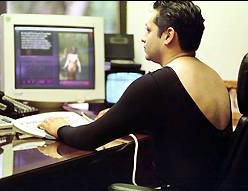|
Virtual Dictionary
Neuromusclar Electrical Stimulation Neuromusclar Electrical Stimulation or NMES is another term for Functional Electrical Stimulation. It is an umbrella term to describe the process of using electrical currents, and electrode arrays to reactivate the peripheral nervous system in individuals who have suffered damage to the spinal cord. Below, we offer a selection of links from our resource databases which may match this term.
Related Dictionary
Entries for Neuromusclar Electrical Stimulation:
Resources
in our database matching the Term Neuromusclar Electrical Stimulation:
Results by page [1] [2] [3] [4] 
 Its early 2009, and the University of Southampton, in the UK, is developing electrical stimulation technology, designed to help stroke patients relearn movement, by duplicating the natural, original nerve impulses. The technology is a direct offshoot of work to decode the electrical signals of the peripheral nervous system. A mis-fire in the teledildonics industry, this early attempt at sexual stimulation in VR fell short after it was discovered it had a minor side effect - bodily secretions caused a lethal electrical discharge. 
 A different paradigm in power generation for implants and prosthetics, combines electrical generation and storage in a single thin three-layer flexible ribbon. Piezoelectric in nature, it builds long-term storage into the electrical ggeneration process. No other battery or powersource required. A different paradigm in power generation for implants and prosthetics, combines electrical generation and storage in a single thin three-layer flexible ribbon. Piezoelectric in nature, it builds long-term storage into the electrical ggeneration process. No other battery or powersource required.Resource Type not Available 
Twenty-five uses to which SimStim, or Simulated Stimulation is likely to be put, which offer true benefits for the world and individuals alike. Nick Carr's infamous blog posting on the electrical consumption of SecondLife and each avatar within it, breaking down their carbon emissions to be the same, roughly, as each person in Brazil. 
A prosthetic device, implanted the lumbar region at the back of the spine, that functions, essentially, as an orgasm control circuit, and bypass route for sexual stimulation without actual physical sex.
Industry
News containing the Term Neuromusclar Electrical Stimulation:
Results by page (12/09/2008)
Deep brain stimulation, which uses electrical stimulation to jolt the brain in pinpointed locations, is use for treating a number of neurological and behavioral conditions, including Parkinson's disease, epilepsy, severe depression, chroni...
(30/01/2009)
European regulators have given a green light to St. Jude Medical to market the company's Libra? and LibraXP deep brain stimulation (DBS) systems for treatment of symptoms of Parkinson's disease. The Libra DBS systems func...
(13/02/2009)
The University of Southampton, in the UK, is developing electrical stimulation technology, designed to help stroke patients relearn movement, by duplicating the natural, original nerve impulses. The technology is a direct offshoot of work t...
(30/11/2008)
Tongue controllers are back in the news again, after research presented at the Society of Neurosciences conference in Washington, DC last week demonstrated that electrical stimulation of the tongue could serve as a secondary feedback to vis...
(31/08/2009)
For over a century, scientists have been using electrical stimulation to explore and treat the human brain. The technique has helped identify regions responsible for specific neural functions?for instance, the motor cortex and pleasure cent...
|
|||||||||||||||||||||||||||||||||||||||||||||||||||

